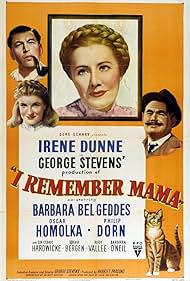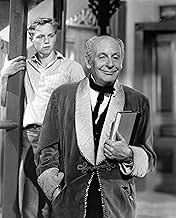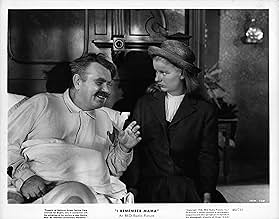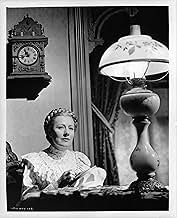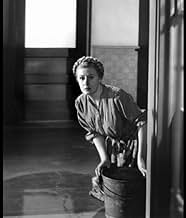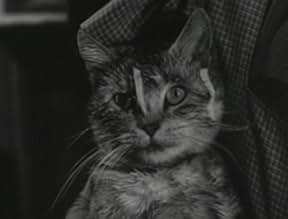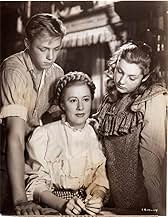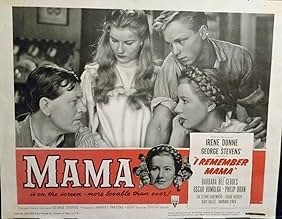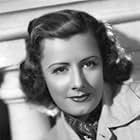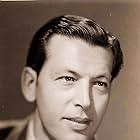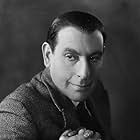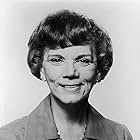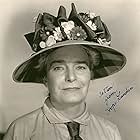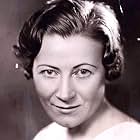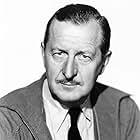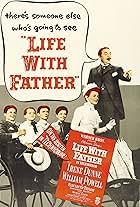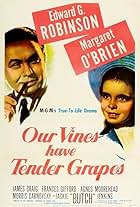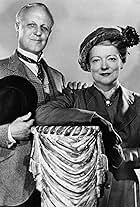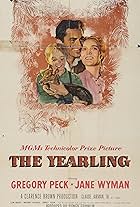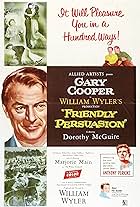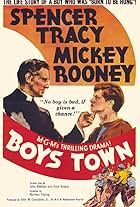IMDb रेटिंग
7.8/10
6.2 हज़ार
आपकी रेटिंग
1910 में एक नार्वेजियन अप्रवासी परिवार के उतार-चढ़ाव के किस्से.1910 में एक नार्वेजियन अप्रवासी परिवार के उतार-चढ़ाव के किस्से.1910 में एक नार्वेजियन अप्रवासी परिवार के उतार-चढ़ाव के किस्से.
- 5 ऑस्कर के लिए नामांकित
- 1 जीत और कुल 8 नामांकन
Cedric Hardwicke
- Mr. Jonahan Hyde
- (as Sir Cedric Hardwicke)
Peggy McIntire
- Christine Hanson
- (as Peggy McIntyre)
Stanley Andrews
- Minister
- (बिना क्रेडिट के)
George Atkinson
- Postman
- (बिना क्रेडिट के)
कहानी
क्या आपको पता है
- ट्रिवियाIrene Dunne worked with dialect coach Judith Sater for two months to perfect her Norwegian accent. Dunne became so immersed in getting her character's voice down that she used the accent around her home with her family.
- गूफ़In the shots of the uncle's trip to San Francisco, as the ferry is pulling into the dock, the Oakland Bay Bridge is seen in the background. This bridge was not built until 1933, yet this movie is set circa 1910.
- भाव
Katrin Hanson: [reading the novel that she's just finished] "For long as I could remember, the house on the Larkin Street Hill had been home. Papa and Mama had both born in Norway but they came to San Francisco because Mama's sisters were here, all of us were born here. Nels, the oldest and the only boy, my sister Christine and the littlest sister Dagmar but first and foremost I remember Mama".
- कनेक्शनEdited into The Waltons: The Awakening (1974)
फीचर्ड रिव्यू
It was a funny old post-war industry. I Remember Mama came out of RKO when that studio was in its darkest phase, and most of its output was creepy little horrors and thrillers, under the guidance of Dore Schary, who a few years after this would add a streak of gritty realism to MGM's dream world. And although this was one of RKO's comparatively small number of A-pictures released around this time, much of its crew were veterans of the B-unit – writer DeWitt Bodeen, cinematographer Nicholas Musuraca and composer Roy Webb had all worked on Cat People amongst other Val Lewton horrors. And director George Stevens, even though his pre-war output was mostly romantic comedies, was emotionally troubled by his wartime experiences and his work subsequently took an a far more sombre tone. But in spite of all this, I Remember Mama is one of the most sweetly uplifting pictures of its era.
This is perhaps not so surprising when we look a bit more closely at the people involved here. It's true, Bodeen's scripts for the Val Lewton horrors were deeply disturbing and filled with uncomfortable psychological insights, but they were also very humane and sympathetic towards villains and victims alike – something you don't often get in the genre. They were also very carefully balanced, with a real understanding of structure. You can see that understanding in I Remember Mama, particularly in the way it uses comedy. Funny moments dovetail into sad ones and vice versa, which gives more weight to the poignant scenes and stops them becoming mawkish.
The cinematography of Musuraca once gave those RKO B-horrors their distinctive look – much of the screen shrouded in mysterious darkness, with key elements picked out in stark white. With I Remember Mama (for which he received his only Oscar nomination) he actually does something quite similar, albeit for very different effect. In interior shots he makes the backgrounds rather indistinct, while the actors are sharp and clear. This encourages us not to focus on the humbleness of the location, but on the people within it. However there are points of brightness on the home set where most of the story takes place, from windows or plates, which gives depth and character to the place when it is needed. In fact, this whole set is a lovely design – each room is very small, but there seem to be numerous doors and stairways coming off room, giving a feeling of cosiness without confinement.
At first glance, I Remember Mama is an anomaly in the post-war career of director George Stevens. With a few exceptions, all his pictures before he did war service in Europe were comedies, and all his pictures after the war are not except this one. However, while there is a lot of humour in I Remember Mama, and Stevens no doubt realised the importance of it, it all comes from Bodeen's screenplay (and John van Druten's stage play). It is not the style of rigorously timed physical comedy that Stevens used to personally build into his pictures, such as the breakfast routine in Woman of the Year.
But there are other ways in which Stevens has changed. He has become a little more subtle and relaxed. His earlier pictures contain a lot of camera movement and very intense close-ups. Now he often calmly keeps the camera back, showing the characters moving around their environment. He is very much concerned with movement within the frame, such as a swinging pendulum that gives a soothing quality to the image. Perhaps the best example is in the hospital when Irene Dunne visits Dagmar in the night. Rather than closing in and making the moment just about mother and daughter, Stevens expresses it through the entire room, with a billowing curtain in one corner keeping a tiny bit of movement going, and here and there children sitting up to listen, really capturing the tenderness and intimacy.
Of course much of the charm of this picture comes not from how it is written or shot, but from who is in it. At the centre of things is a typically understanding and believable performance from Irene Dunne, perhaps the greatest actress never to win an Academy Award. She is supported by steady turns from Philip Dorn and Barbara Bel Geddes. However, the most truly excellent contributions are those of Edgar Bergen, Ellen Corby and, of course, Oskar Homolka. It is the impeccable timing and rapport between these three that make that all-important comedy element work.
I have mostly looked at this picture from the point of its being at odds to the careers of its creators, and some might say this is missing the point. After all, it simply goes to show that truly creative people are versatile. Still, it fascinates me that all that darkness and pessimism of RKO in the 1940s could still give us something as stirring and beautiful as I Remember Mama.
This is perhaps not so surprising when we look a bit more closely at the people involved here. It's true, Bodeen's scripts for the Val Lewton horrors were deeply disturbing and filled with uncomfortable psychological insights, but they were also very humane and sympathetic towards villains and victims alike – something you don't often get in the genre. They were also very carefully balanced, with a real understanding of structure. You can see that understanding in I Remember Mama, particularly in the way it uses comedy. Funny moments dovetail into sad ones and vice versa, which gives more weight to the poignant scenes and stops them becoming mawkish.
The cinematography of Musuraca once gave those RKO B-horrors their distinctive look – much of the screen shrouded in mysterious darkness, with key elements picked out in stark white. With I Remember Mama (for which he received his only Oscar nomination) he actually does something quite similar, albeit for very different effect. In interior shots he makes the backgrounds rather indistinct, while the actors are sharp and clear. This encourages us not to focus on the humbleness of the location, but on the people within it. However there are points of brightness on the home set where most of the story takes place, from windows or plates, which gives depth and character to the place when it is needed. In fact, this whole set is a lovely design – each room is very small, but there seem to be numerous doors and stairways coming off room, giving a feeling of cosiness without confinement.
At first glance, I Remember Mama is an anomaly in the post-war career of director George Stevens. With a few exceptions, all his pictures before he did war service in Europe were comedies, and all his pictures after the war are not except this one. However, while there is a lot of humour in I Remember Mama, and Stevens no doubt realised the importance of it, it all comes from Bodeen's screenplay (and John van Druten's stage play). It is not the style of rigorously timed physical comedy that Stevens used to personally build into his pictures, such as the breakfast routine in Woman of the Year.
But there are other ways in which Stevens has changed. He has become a little more subtle and relaxed. His earlier pictures contain a lot of camera movement and very intense close-ups. Now he often calmly keeps the camera back, showing the characters moving around their environment. He is very much concerned with movement within the frame, such as a swinging pendulum that gives a soothing quality to the image. Perhaps the best example is in the hospital when Irene Dunne visits Dagmar in the night. Rather than closing in and making the moment just about mother and daughter, Stevens expresses it through the entire room, with a billowing curtain in one corner keeping a tiny bit of movement going, and here and there children sitting up to listen, really capturing the tenderness and intimacy.
Of course much of the charm of this picture comes not from how it is written or shot, but from who is in it. At the centre of things is a typically understanding and believable performance from Irene Dunne, perhaps the greatest actress never to win an Academy Award. She is supported by steady turns from Philip Dorn and Barbara Bel Geddes. However, the most truly excellent contributions are those of Edgar Bergen, Ellen Corby and, of course, Oskar Homolka. It is the impeccable timing and rapport between these three that make that all-important comedy element work.
I have mostly looked at this picture from the point of its being at odds to the careers of its creators, and some might say this is missing the point. After all, it simply goes to show that truly creative people are versatile. Still, it fascinates me that all that darkness and pessimism of RKO in the 1940s could still give us something as stirring and beautiful as I Remember Mama.
टॉप पसंद
रेटिंग देने के लिए साइन-इन करें और वैयक्तिकृत सुझावों के लिए वॉचलिस्ट करें
- How long is I Remember Mama?Alexa द्वारा संचालित
विवरण
- रिलीज़ की तारीख़
- कंट्री ऑफ़ ओरिजिन
- भाषाएं
- इस रूप में भी जाना जाता है
- George Stevens' Production of I Remember Mama
- फ़िल्माने की जगहें
- उत्पादन कंपनी
- IMDbPro पर और कंपनी क्रेडिट देखें
बॉक्स ऑफ़िस
- बजट
- $30,68,000(अनुमानित)
- चलने की अवधि2 घंटे 14 मिनट
- रंग
- पक्ष अनुपात
- 1.37 : 1
इस पेज में योगदान दें
किसी बदलाव का सुझाव दें या अनुपलब्ध कॉन्टेंट जोड़ें

